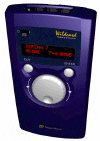|
NGC-superMAX (Argo Navis) Product Summary Features The Argo Navis is one of the most sophisticated devices for rapidly and confidently locating celestial objects. The Argo Navis brings not only accurate positioning information to you telescope but also provides an enormous detailed database of tens of thousands of objects. A wealth of information is available at your fingertips with a simple spin of the dial, including the following:
The Argo Navis can accommodate a large range of mounts including Dobsonians, Forks and German Equatorials. The Argo Navis operates completely standalone as a handheld device powered by (4) AA batteries or an optional external DC source. After fitting a pair of optical encoders to your mount, using the Argo Navis is simple. Perform a quick star alignment and off you go. There is no need to level or accurately polar align your mount. It's fast and easy. Using the innovative Intelligent Editing System™, objects from the built-in catalogs can be accessed quickly and easily by name. You can select a particular object and then the Argo Navis can provide you with "guiding" information that will allow you to zero in on it by simply manually turning the scope. Alternatively, as you move your scope, objects of interest can be reported to you on the display in real time. The Argo Navis has a powerful 32-bit CPU at its heart that will easily allow you to continuously track satellites. The sophisticated software even accounts for precession, nutation and atmospheric refraction. A battery backed real-time clock provides local time, UTC time, Julian date and sidereal time. The versatile and powerful tour mode allows you to tailor your searches of the sky so that you may seek to find the types of objects that interest you the most, be they easy or highly challenging. Though designed for standalone use, the Argo Navis can also be interfaced to your PC or laptop, which brings about a wealth of additional features. It can operate with many of the popular sky charting packages, such as TheSky™ from Software Bisque, to provide you with a tracking cursor display. Using the supplied Argonaut™ utility, it even lets you store into its FLASH memory over a thousand of your own user-defined objects including the magnitudes and descriptions. You can erase them and store new ones as often as you like. Argo Navis firmware and catalog upgrades can be downloaded free from the internet! The Argo Navis can make your observing sessions more enjoyable and rewarding. Modes MODE ALIGN allows you to align the telescope on the "current" object. The current object is the last object referenced via one of the following modes: ALIGN STAR, CATALOG, IDENTIFY or TOUR. Therefore, you can align the Argo Navis on any object in the database. MODE ALIGN STAR is a quick and convenient method to align on any of 35 bright naked-eye stars. MODE AZ ALT displays the position of your telescope in an altitude-azimuth coordinate system. MODE CATALOG allows you to look up an object by name and then to GUIDE to it or retrieve more information on it. Objects are grouped in catalogs. MODE ENCODER allows you to check for proper functioning of the encoders. MODE EQ TABLE allows you to view and control the equatorial table timer. MODE FIX ALT REF allows you to define the initial altitude encoder reference point based on the initial mechanical alignment of the scope. MODE IDENTIFY attempts to identify an unknown object or to locate the nearest object of interest. The Argo Navis searches its database for the object that is nearest to where the telescope is pointing and which matches the criteria specified in the search. MODE RA DEC displays the position of your telescope in a right ascension-declination coordinate system. MODE SETUP gives access to various setup menus as follows:
MODE SIDEREAL displays the local apparent sidereal time. MODE STATUS allows you to examine:
MODE TIME shows the following:
MODE TIMER provides stopwatch functionality in either synodic (Sun/normal) or sidereal (star) rate. MODE TOUR allows you to tour objects of interest based on search criteria that you enter. Go to JMI's Home Page
|
